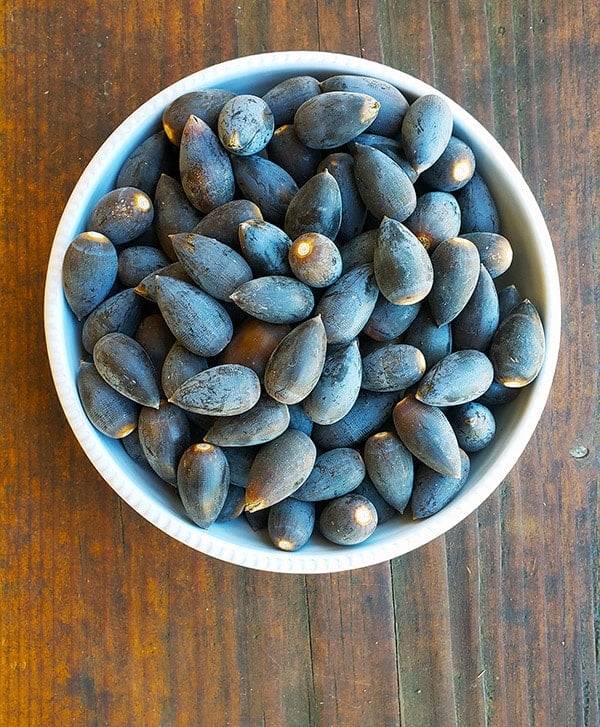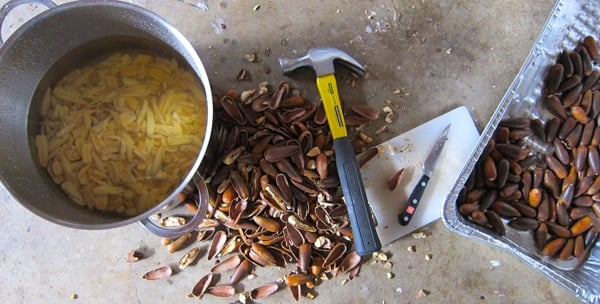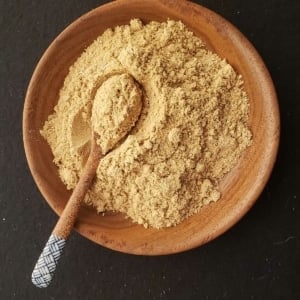The Best Way to Make Acorn Flour
September 26, 2013 | Updated February 12, 2021
As an Amazon Associate I earn from qualifying purchases.
There is really only one good way to make quality acorn flour: Cold leaching.
Leaching, as is pulling something out. In this case, that something is tannin, which is present in all acorns. Different acorns have different levels of tannins, but in general oaks of the red oak family have more, the white oak family less. One, the Emory oak of the Sonoran Desert, has almost none at all.

Before I go much further, let me answer the question in many of your minds: Why the heck would I bother making flour from acorns? First, flavor. It’s a lot like chestnut flour: Nutty, a little sweet and just generally interesting. Second, nutrition. Acorns vary in nutrition. Some are very starchy, some oily, a few high in protein. Third, it’s just kinda fun to make something useful and tasty out of something many of us mistakenly believe is poisonous.
In my original post about eating acorns, I recommended the boiling water method of leaching out all those bitter tannins. This works fine, and is comparatively fast; you can have a batch of acorns leached in the time it takes to watch a football game, which is about three hours for those of you who have never actually watched a football game.
The problem? The resulting acorn flour is very dark, and the boiling process destroys a key starch in the acorns — a starch that acts a lot like gluten in wheat, i.e., it helps the acorn flour stick to itself, or to thicken gravy or a roux.
I have found myself using acorn flour mostly for making roux, coating meats or as a flour additive in baked goods, tortillas, and pasta. So that starch is pretty important to me.
Cold leaching solves this problem. It preserves the starches and, when dried properly, keeps the flour lighter — closer to whole wheat than that dark chocolate brown you can get with boiling water-leached flour. The tradeoff is time. It takes at least a few days to “clean” your flour, and it can take more than a week.
But it’s easy time. All you need to do is tend your flour once or twice a day. Here’s how to go about it.

Start with acorns. I know, obvious, right? But know that they need not be fresh. Last summer I made a batch of flour from some red oak acorns I’d picked the previous October. I’d laid them out in a shallow layer in a large tray and just let them dry out. When it came time to crack the shells, it was so much easier than with fresh acorns; fresh acorn shells are pliable, and don’t crack like, say, a hazelnut’s shell.
You will need to soak your shucked acorns in water overnight, though — and it’s the devil to get the papery skins off dried red oak acorns. Those skins darken the flour and are very tannic.
I don’t really bother working too hard at removing the skins, but there is a trick that helps get them off (the skins are called the “test”): Freeze your acorns fresh. When they thaw and you crack them, the skin comes off a lot easier. The problem is storage. Acorns are bulky and can take up a lot of space in your freezer. But hey, if you want that skin off, it will help.
Regardless, shuck your acorns into water. This helps prevent them from oxidizing. I find that if I leave acorn nutmeats out, they turn brown over time. If they are fresh acorns, the papery skins should slip right off once the acorn has soaked a bit.

If you have some acorns with worm-eaten bits, you can cut off the bad part if you want to and toss the good part into the bucket of water.
Once your acorns are all shucked, put enough of them to fill a blender or food processor (use a food processor if your blender isn’t too strong) up about 1/3 of the way. Add enough water to fill the bowl of the processor or blender up halfway. Buzz the crap out of it until you get what looks like a coffee milkshake. Play a mean trick on your friends by pouring them some, and watch the hilarity.
Now, you will need a large container. The absolute perfect container to my mind are those big glass jars you get at the Asian market to make kimchi. You can buy gallon glass jars online or in many hardware stores for about $15. Pour the “coffee milk shake” into the big jar and keep adding more until you have about 50 percent ground acorns and 50 percent water. Cap the jar.

Put the jar into the fridge or just a cool place — it must be below 75°F or the flour will ferment — and walk away. Each morning, pour off the water, being careful to not lose too much of your acorn flour. Refill the jar, cap it and shake the hell out of it, turning it upside down to make sure all the acorn flour is suspended in the water. Repeat as necessary.
Now, there is an added tip you can do to make an even higher quality acorn flour: Strain the water every day through cheesecloth. Why? Look at the picture above: See the top layer that’s lighter in color? It’s acorn fat and starch.
It’s so light some will pour off every day as you change the water. Straining through cheesecloth preserves this fat and starch and will make your flour even richer and tastier. Do this and you will be rewarded with flavor later.
You know your acorn flour is ready when you roll some around in your mouth and it tastes really bland. Not tannic or bitter at all. Roasting can eliminate a little bit of tannin, but we’re not roasting in this case, so you want the flour to be as “clean” as possible.
For California Valley oak acorns, Eastern white oak acorns or other “sweet” acorns, this process could take as few as three days. But 5 days is more normal. California black and blue oaks take about a week. And Eastern red oak acorns? They took 10 days. When in doubt, go another day. You can’t hurt the flour by leaching a few extra days.
Now you have a bunch of soaking wet flour. First thing you will need is cheesecloth. Any supermarket will have it, but I have taken to using real cheesecloth, i.e., cloth actually used in cheesemaking. You can buy real cheesecloth online or in specialty shops.
Line a fine-mesh strainer with some cheesecloth and set it over the sink. Pour the water in the jar through it, catching all the flour.

Squeeze the cloth tight around the flour to extract as much water as possible. This is why I use real cheesecloth — the cheap stuff at most supermarkets is too porous and thin to do the job very well, forcing you to squeeze less and spend more time drying — and the longer the drying time, the darker the flour. You will be left with what looks a lot like a ball of clay.
Tip: Let the water in the bowl settle for 1 hour. Carefully pour off the water and you will see a layer of what looks like beige house paint or melted coffee ice cream. This is acorn starch and fat. Use a spatula to scrape it into the container you are drying your acorns in.
Now you need to really dry your flour, unless you plan on making something with it right away. I almost never do this.

Spread your wet flour on a baking sheet, or on a solid dehydrator tray; the trays you use for fruit leather. I prefer the dehydrator because I can dry at a lower temperature. Or, if you do this in summer, you can dry outdoors or in a hot garage.
Dry at as low a temperature as you can. I use a dehydrator set at 95°F. Check in on your flour every few hours, turning it over so it dries evenly. This can take anywhere from an hour to a day. You want the flour to be dead dry. No moisture.
You are almost there. You now have what is essentially acorn “corn meal,” a gritty, coarse “flour” you can use to make polenta with; it’s pretty good, actually. But to make real flour you need to grind it one more time.
To turn your acorn polenta into acorn flour, grind the dried meal in a spice grinder, coffee grinder, or, best yet, a Vitamix fitted with dry blades. This is what I use, and it is worth every penny.
If you have a flour sifter this is a good time to break it out. Grind and sift into a clean bowl until you have nothing but pure, powdery goodness. A typical coffee grinder will require about 35 seconds of grinding to get there, my Vitamix takes only 15 seconds.
Your acorn flour is mildly fragile, especially if you are dealing with high fat acorns, like blue oaks, live oaks and red oaks. I store mine in quart Mason jars in the fridge or freezer. Stored this way, the flour will last for several years — which is good, because oaks don’t drop huge amounts of acorns every year.
Does all this sound like a lot of work? Well, I won’t lie to you: It is. And like I said, this process makes the highest quality acorn flour possible. There are easier ways, but the quality of the flour is inferior. This will make you quite aware about how we take regular wheat flour for granted. Do this and I can guarantee you will not be tossing around acorn flour the way you would with all-purpose. It’s too precious.
How to Make Acorn Flour
Equipment
- Cheesecloth
- A large jar
- Blender
Ingredients
- 3 pounds acorns
- Water
Instructions
- Start by shelling your acorns into a bowl of cool water. This will take about an hour, more or less. I typically do it while watching television. Putting the shells in water immediately will prevent them from oxidizing.
- Once you have all the acorn meats shelled (a little of the brown skin, called the test, is OK), puree them with water in the blender. Pour this into your large jar and set in a cool place, cooler than about 60°F. I will often refrigerate it. Temperatures too warm will cause it to ferment.
- Every day, up to twice a day, carefully pour off the water and replace it. As an added, but optional step, you can pour the last of each day's water -- the stuff with the most fine sediment in it -- into a baking sheet and let the water evaporate from it. What's left is pure acorn starch, which you can use exactly like corn starch.
- After about four or five days, taste the meal. It should be bland, not bitter. If it is still bitter, keep changing the water until it's not. Each species of acorn will need different leaching times.
- When the wet meal is ready, move it to a strainer lined with cheesecloth. Strain out as much water as possible. In this step, you really do want to capture this last water because it is loaded with starch. Let that water evaporate from a baking sheet.
- Lay out your wet acorn meal to dry. I use a dehydrator set at 95°F. Shoot for conditions like that. An oven is too hot and will turn the flour dark brown.
- When the meal is completely dry, add it and any chunks of acorn starch to a spice grinder or blender and buzz until completely fine, like wheat flour. Store in a jar in the fridge or freezer, so the acorn fats don't go rancid. It will keep this way a year or more.
Notes
Nutrition information is automatically calculated, so should only be used as an approximation.







Great article.
Thanks very much!
Hi Hank,
It was interesting to read your article about acorns, but I have a question.
Are chestnuts considered as acorns and are horse chestnuts safe to use to extract flour
I tried eating horse chestnuts once until I realized that they were harming my voice, I mistook them for the normal chestnuts we usually buy.
Thanks and regards.
George
George: No, chestnuts are not considered acorns, and so far as I know, horse chestnuts are toxic.
We have hundreds of thousands of acorns here on our apt. grounds. I was wondering what we could do with them, and lots of them are HUGE! I also wanted to try germinating and planting some to help our earth, as more trees can help slow global warming. Are there any interested parties who might benefit and/or help in these endeavors ? I have limited room to store acorns, but i will do what i can starting tomorrow. Thanks for the great article on acorns, and for the good advice .
Just tried chestnuts for the first time and they are great!! Was up set over the missed treats for years as we had chestnut trees n Michigan before the y all died. sure missed out on a good treat instead of raking and tossing. Now to try all kinds of acorns. thanks for the detailed instructions.
Hank, you may be interested to know that this year my husband & I discovered that the blue oaks where we live in Fairfax, California actually seem to consistently drop acorns that are sweet enough to eat roasted right out of the shell. We were shocked — we expected them to be inedible raw, but they were so mild I tried popping them right in the oven, and they were absolutely fine — they have a more complex flavor than chestnuts, but they’re perfect for putting right into a soup. (The raw nuts do have a bit of that felty mouthfeel despite the mild flavor, so I’m leaching the ones I’m processing into flour.) They’re also gigantic and particularly plentiful this year, so I invite anyone who happens to live near Marin County to come help themselves before the oakworms and the squirrels get ’em all — some of the trees in town are so huge you can pick up a bushel in no time.
What do you do with the separated acorn oil? You said spatula into the container you are drying your acorns in but that confuses me? Do you add it back into the dried meal before grinding it with coffee grinder? Or do you save it separately and use it to add to the recipe?
Would you please clarify the step about scraping out the fats and starches? What are we scraping that into? Our wet flour? And are we mixing it into the flour if so? Or are we saving that for another separate purpose altogether? Thanks!
Self: The “cream” is acorn starch and that can be tossed back into the flour itself, or separated and dried and used like corn starch.
Do you have to do anything to acorns if you just want to eat them as nuts ? Not make flour , just eat them ?
Diane: Yes, you have to leach out tannins. They cannot be eaten as nuts, for the most part. Too bitter. There is one place where there are acorns “sweet” enough to eat roasted, and that is southern Arizona with the Emory Oak.
Have a question about the cold water leaching process, the tip an out straining the liquid through cheesecloth to capture acorn fat and starches. What do you do with what the cheesecloth captures? Put back into the original jug? Wasn’t sure that would be correct, because it seems like you’re just going to strain it over and over again that way. Or would you start a new jar?
If you could clarify, that would be very helpful. The article is very interesting, and a useful guide — have lots of acorns dropped into my yard, like the idea of being able to use them. Thanks!
Joan: Yes, put it back in the original jug.
Many years ago a friend told me about his technique for leaching tannins from acorn flour. He put it in a nylon stocking and suspended it in the toilet tank. Left it for a week, and had sweet flour for baking.
Thanks for sharing! I am looking into a keto diet and I am wondering if acorn flour is low in carbs? I am overweight, and have health issues, like M. S. From what I have read so far on acorns , seems like they would be good for me. Can you use the flour to make breads and noodles?
Debra: It depends on the acorn. Some are low in carbs, some very high in carbs. It is species dependent. In general, you want red oak acorns, which tend to be fattier.
I had a camp counselor that use to put his acorns in a mesh bag in the toilet tank, not the bowl. Ingenuity. Every time you flush it rinses the acorns.
In Texas we have an Burr Oak tree that can have LARGE acorns. The size of small oranges. Have you ever experimented with them? Would you use the same process?
Also, I brew beer. Have you ever experimented using acorns as a starch in beer?
Thanks
Will: Yes, I love working with burr oaks! And no, I have not experimented with acorns in beer.
Is this flour gluten free?
Ron: Yes it is.
While doing the cold leaching method have you ever noticed any black spots in the jar that look a little like mold? I’m currently leaching fine ground acorns and noticed some of these spots around day 6. I’ve never had this happen with chunky/coarse ground.
Chris: No, I’ve never noticed this. Not sure what it might be.
Restaurants and bars can be a good source for free large glass jars. Bar olives and maraschino cherries often come in those jars. High-volume restaurants generate more waste than a local corner joint, but any place is worth asking.
A restaurant you frequent is a good bet, because you’ll have to ask them to save the jars for you, unless you happen to be there on the day they empty a jar. Telling them an interesting story for how you’ll use the jar is a good way to get them invested in your plan !
Dave: Good tip!
During the cold leeching process, when you pour off the water each day through cheesecloth to collect the fat and starch, what do you do with it? Do you put it back in the container when you add fresh water?
Ed: I put the starch back into the container, yes.
What is the raw nut to leeched wet powder ratio? (like 5 lbs of nuts on the hoof to make a 1/2 of flour???)
Michelle: Varies every time.
Wouldn’t be easier to just strain the water/flour mixture through a filter paper in a conical sieve like they use to filter oil in the fryers at restaurants… then you would lose a lot less…
Turquiose: Yes, if you have a very large set up like that. But most people don’t Actually, the very best way I still need to do myself: You need a large mesh frame, like the top section of a screen door with very fine mesh. Set cheesecloth over that and spread the flour over it. Then carefully pour water over it all and catch the water below. Apparently you can cold leach flour in an afternoon this way.
Hank,
At a local Asian market I can buy something called acorn starch, would that be the same as acorn flour? It looks and acts like flour, though of course the color and taste is different. I have made gnocchi from it with good results, but it does darken considerably when cooked. Most of the label on the package is in Chinese so that is no help. If this acorn starch is the same as acorn flour then I have ready access to it.
Ponzio: It’s not, but they are related. The starch is extracted from the flour.